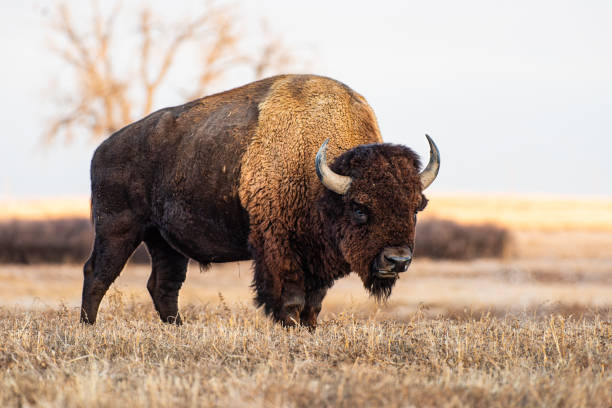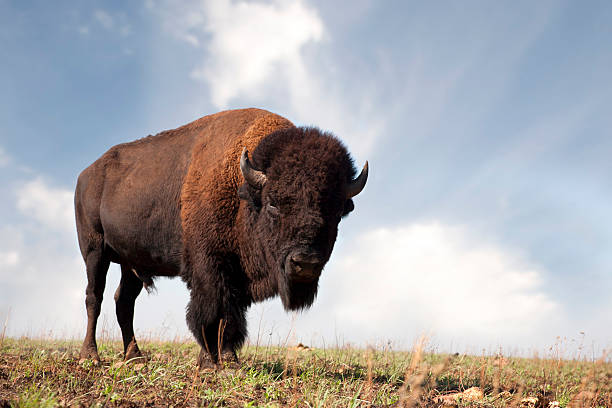Table of Contents
Scientific Classification
| Kingdom | Animalia |
| Phylum | Chordata |
| Class | Mammalia |
| Order | Artiodactyla |
| Family | Bovidae |
| Genus | Bison |
| Species | Bison bison |
| Scientific Name | Bison bison |
Description
The American Bison (Bison bison), often referred to as the buffalo, holds the title of the largest land mammal in North America. These remarkable creatures are recognized for their impressive size, thick dark brown fur, humped shoulders, and distinctive curved horns. Male bison, known as bulls, can reach weights of up to 2,000 pounds (900 kg) and stand around 6 feet (1.8 meters) tall at the shoulders. Females, or cows, are smaller yet still quite strong, weighing as much as 1,200 pounds (540 kg).
Bison are celebrated for their strength and resilience. Despite their hefty appearance, they can run at speeds of 35 miles per hour (56 km/h), jump over obstacles, and swim across rivers with ease.
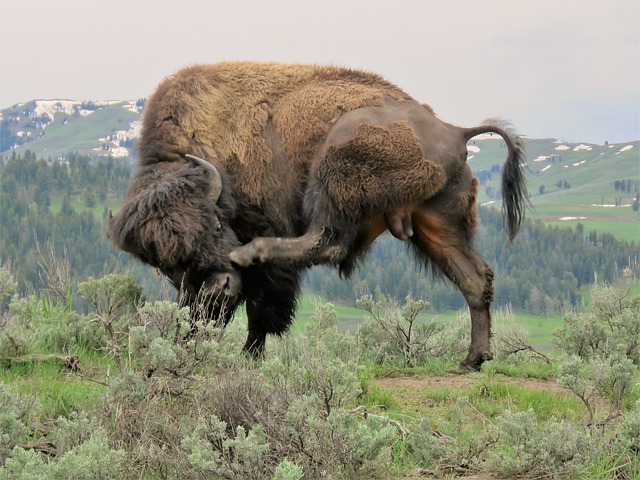
Distribution
American Bison once roamed freely throughout much of North America, journeying from the eastern forests all the way to the Rocky Mountains, and from Canada down to Mexico.
Today, bison primarily inhabit protected reserves, national parks, and private ranches across the U.S. and Canada. Notable locations include:
Yellowstone National Park, the only place in the U.S. where bison have lived since prehistoric times.
Badlands National Park in South Dakota.
National Bison Range in Montana.
Wood Buffalo National Park in Canada.
Habitat
Bison thrive in grasslands, prairies, and open woodlands, where they graze freely. They prefer areas with:
Plenty of grass and shrubs for food
Access to water sources like rivers, streams, and lakes
Expansive space for migration and herd movement
They can survive hot summers and harsh winters, which makes them very adaptable. In winter, they use their powerful heads to push aside snow to reach buried vegetation.
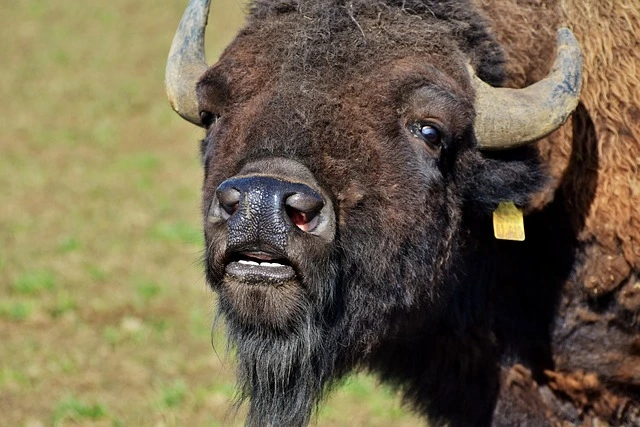
Diet
American Bison are herbivores, with a diet consisting primarily of:
Grasses (primary food source)
Sedges
Herbs and shrubs
Lichen and twigs (in winter when grass is scarce)
Bison are ruminants. This means they have a special digestive system. It has multiple stomach chambers. These help them break down tough plant materials efficiently. They graze for most of the day. Then, they regurgitate their food to chew it again before digestion.
Behavior
Bison are very social creatures that live in herds of varying sizes. Their behaviors include:
Herd Living: Female bison and their calves tend to stay in large groups, while bulls typically wander alone or form small bachelor groups.
Seasonal Migration: They travel long distances in search of food and water.
Wallows: Bison roll in dirt patches, known as wallows, to fend off insects and cool down.
Rutting Season: During the breeding season, males engage in head-butting contests to establish dominance.
Communication: They communicate through grunts, bellows, and various body language signals.
Lifespan
In the wild, American Bison usually live between 15 and 20 years. However, in protected environments, some individuals can live as long as 25 years. Their lifespan is influenced by various factors, including predators, food supply, and human impact.
Reproduction and Lifecycle
The mating season, referred to as the rut, takes place from July to September. During this period, dominant bulls engage in battles for mating rights, showcasing their strength through loud bellowing and head clashes.
Gestation: This lasts about 9.5 months.
Birth: Calves are typically born in the spring, weighing between 30 to 70 pounds (14 to 32 kg).
Weaning: Calves nurse for 7 to 8 months but begin grazing within a few weeks.
Females reach reproductive maturity at 2 to 3 years, while males usually wait until they are 6 years old, at which point they are strong enough to compete with other bulls.
Mothers are highly protective, and young calves quickly learn to stay close for their safety.
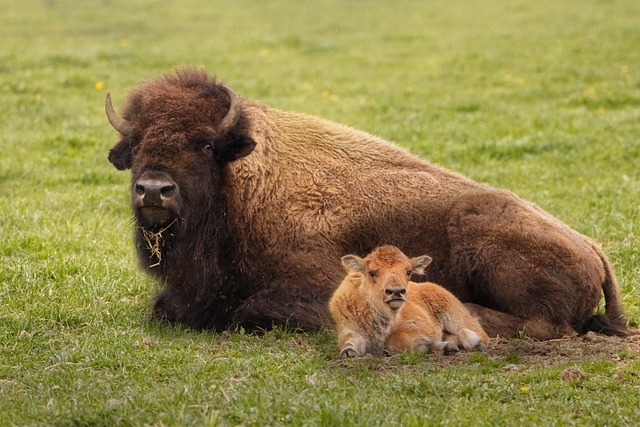
Predators
Due to their large size, adult bison have few natural predators. However, calves and weak individuals may fall prey to:
Wolves (primary natural predator)
Grizzly Bears (opportunistic hunters targeting young or injured bison)
Mountain Lions (occasionally attack calves)
Humans (historically the greatest threat due to hunting and habitat destruction)
Adaptations
Bison possess several impressive adaptations that enable them to thrive in the wild:
Thick Fur: Provides insulation against frigid winter temperatures.
Massive Hump: Houses powerful muscles that assist them in navigating through deep snow.
Large Lungs: Designed for high-altitude living and extensive migrations.
Agility and Speed: Even with their large size, they can outpace most predators.
Sharp Horns: Serve as a means of defense against threats and competition.
Conservation Status
The American Bison was nearly extinct at one point in history. During the 19th century, excessive hunting and loss of habitat caused their population to plummet from millions to fewer than 1,000. Fortunately, due to dedicated conservation efforts, their numbers have rebounded to around 500,000 today. However, it’s important to note that the majority of these bison are found in private herds.
Major Threats:
Habitat Loss: Due to agriculture and urbanization.
Genetic Dilution: Many bison interbreed with domestic cattle.
Climate Change: Alters grassland ecosystems.
Human Conflicts: Ranchers see bison as competitors for grazing land.
Conservation Efforts:
Protected Reserves: Areas such as Yellowstone and various national wildlife refuges.
Reintroduction Programs: Initiatives aimed at restoring bison populations in both indigenous and conservation lands.
Legal Protections: In 2016, the U.S. government designated the bison as the National Mammal, underscoring the significance of conservation efforts.
Conclusion
The American Bison is a symbol of strength and endurance. It holds significant importance in North America’s history and ecosystems. Thanks to conservation initiatives, these remarkable animals have been brought back from the brink of extinction, allowing future generations to witness them in their natural habitats. Nevertheless, continuous efforts are essential to safeguard their environment and maintain their genetic diversity.
Recognizing the importance of these magnificent creatures is crucial for preserving a vital aspect of our ecological and cultural legacy.
